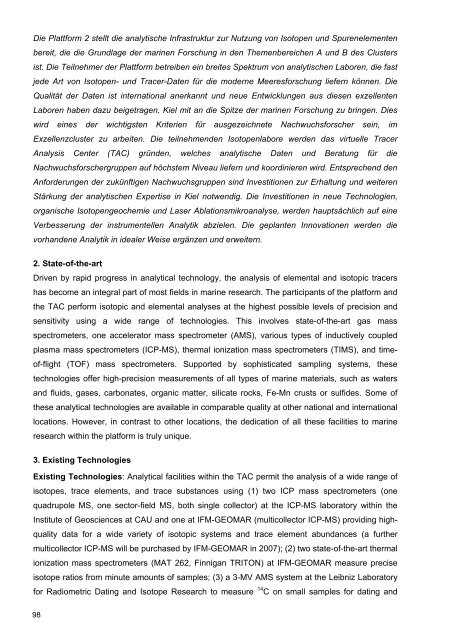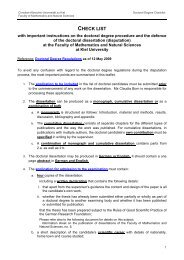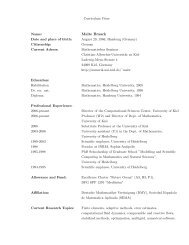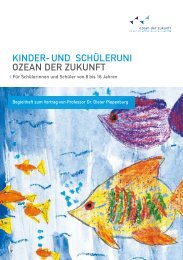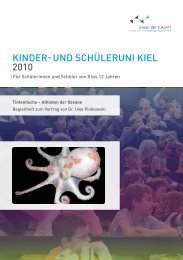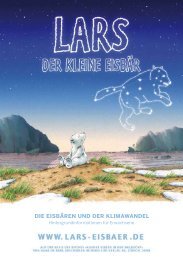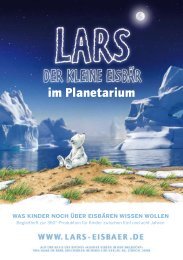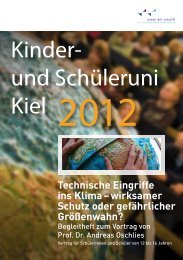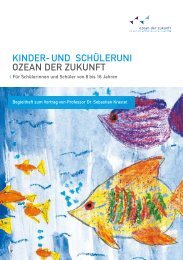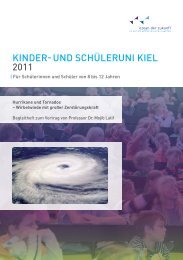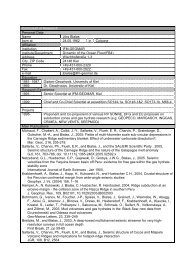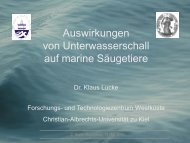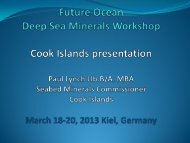Untitled - The Future Ocean
Untitled - The Future Ocean
Untitled - The Future Ocean
- No tags were found...
Create successful ePaper yourself
Turn your PDF publications into a flip-book with our unique Google optimized e-Paper software.
Die Plattform 2 stellt die analytische Infrastruktur zur Nutzung von Isotopen und Spurenelementenbereit, die die Grundlage der marinen Forschung in den <strong>The</strong>menbereichen A und B des Clustersist. Die Teilnehmer der Plattform betreiben ein breites Spektrum von analytischen Laboren, die fastjede Art von Isotopen- und Tracer-Daten für die moderne Meeresforschung liefern können. DieQualität der Daten ist international anerkannt und neue Entwicklungen aus diesen exzellentenLaboren haben dazu beigetragen, Kiel mit an die Spitze der marinen Forschung zu bringen. Dieswird eines der wichtigsten Kriterien für ausgezeichnete Nachwuchsforscher sein, imExzellenzcluster zu arbeiten. Die teilnehmenden Isotopenlabore werden das virtuelle TracerAnalysis Center (TAC) gründen, welches analytische Daten und Beratung für dieNachwuchsforschergruppen auf höchstem Niveau liefern und koordinieren wird. Entsprechend denAnforderungen der zukünftigen Nachwuchsgruppen sind Investitionen zur Erhaltung und weiterenStärkung der analytischen Expertise in Kiel notwendig. Die Investitionen in neue Technologien,organische Isotopengeochemie und Laser Ablationsmikroanalyse, werden hauptsächlich auf eineVerbesserung der instrumentellen Analytik abzielen. Die geplanten Innovationen werden dievorhandene Analytik in idealer Weise ergänzen und erweitern.2. State-of-the-artDriven by rapid progress in analytical technology, the analysis of elemental and isotopic tracershas become an integral part of most fields in marine research. <strong>The</strong> participants of the platform andthe TAC perform isotopic and elemental analyses at the highest possible levels of precision andsensitivity using a wide range of technologies. This involves state-of-the-art gas massspectrometers, one accelerator mass spectrometer (AMS), various types of inductively coupledplasma mass spectrometers (ICP-MS), thermal ionization mass spectrometers (TIMS), and timeof-flight(TOF) mass spectrometers. Supported by sophisticated sampling systems, thesetechnologies offer high-precision measurements of all types of marine materials, such as watersand fluids, gases, carbonates, organic matter, silicate rocks, Fe-Mn crusts or sulfides. Some ofthese analytical technologies are available in comparable quality at other national and internationallocations. However, in contrast to other locations, the dedication of all these facilities to marineresearch within the platform is truly unique.3. Existing TechnologiesExisting Technologies: Analytical facilities within the TAC permit the analysis of a wide range ofisotopes, trace elements, and trace substances using (1) two ICP mass spectrometers (onequadrupole MS, one sector-field MS, both single collector) at the ICP-MS laboratory within theInstitute of Geosciences at CAU and one at IFM-GEOMAR (multicollector ICP-MS) providing highqualitydata for a wide variety of isotopic systems and trace element abundances (a furthermulticollector ICP-MS will be purchased by IFM-GEOMAR in 2007); (2) two state-of-the-art thermalionization mass spectrometers (MAT 262, Finnigan TRITON) at IFM-GEOMAR measure preciseisotope ratios from minute amounts of samples; (3) a 3-MV AMS system at the Leibniz Laboratoryfor Radiometric Dating and Isotope Research to measure 14 C on small samples for dating and98


